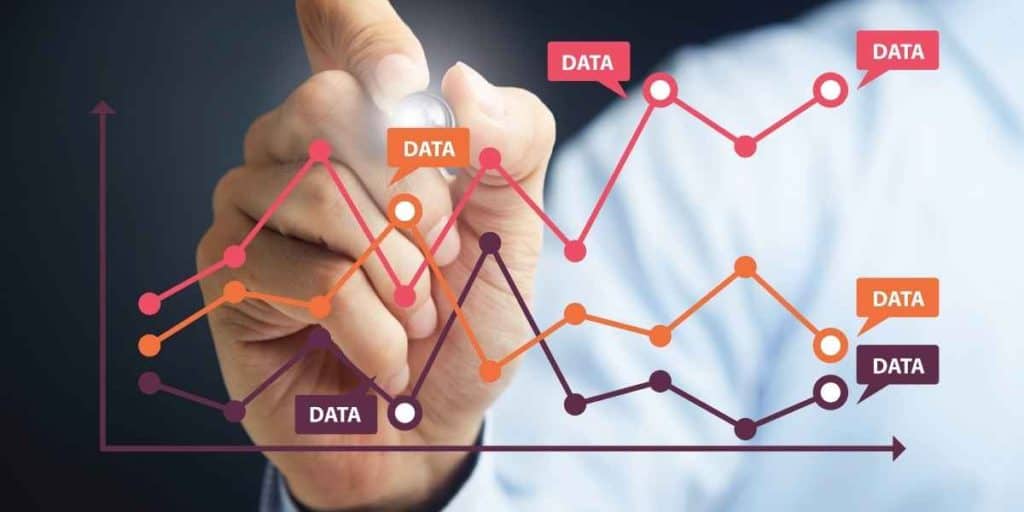In today’s world, most companies, local businesses, startups, and corporations use certain data to analyze past patterns and predict future trends. However, as the data set grows and the information’s volume enlarges, companies need a tool that helps them make sense of the numbers – this, for data science, is R.
Data scientists use the programming language R because it is designed for statistics. It offers data-wrangling packages, visualization tools, and supports statistical models while being optimal for academia. R is easy to learn and can help data scientists organize unstructured data.
Find out the pros, cons, and alternative or R programming language in data science below.
Important Sidenote: We interviewed numerous data science professionals (data scientists, hiring managers, recruiters – you name it) and identified 6 proven steps to follow for becoming a data scientist. Read my article: ‘6 Proven Steps To Becoming a Data Scientist [Complete Guide] for in-depth findings and recommendations! – This is perhaps the most comprehensive article on the subject you will find on the internet!
Table of Contents
What Is R?
R is a programming language built for statistics. R is also a free, open-source software environment preferred for statistical computing.
According to the TIOBE Index published in August 2020, R is the 8th most popular programming language, 12 positions up compared to August 2019. The popularity trend of this language follows the increasing need for companies to obtain and make sense out of data.

The R software environment, also known as the GNU package, is partially written in R, which makes it self-hosting, to an extent. Data scientists, students, and any other interested can find the program on The R Project for Statistical Computing website.
Understanding the link between this programming language and the statistical fields is essential to comprehend why data scientists have made this their preferred software.
Indeed, data science represented the blend of several statistical disciplines in the past. While it still uses principles of statistics, the interdisciplinary field of data science focuses on digital data. Today’s data science uses statistical principles, mathematical algorithms, and machine learning to help companies and organizations use data to the fullest.
Rather than examining past patterns, data science models aim to foresee future trends and consumer behaviors. Some of the specific topics that fall under the umbrella field of data science include:
- Data mining
- Development of statistical software
- Data analysis
- Big data mining and analysis
- Data-analytics problems identification
- Collecting large sets of data (structured and unstructured)
- Organizing the data to let a pattern emerge
- Visualization of data
- Industry or company-specific tasks
What Is R Used For?
R is no longer the simple programming language it once was. While still intuitive, powerful, and easy to use, today, there are many things you can use R for. The program has a comprehensive list of analytical packages and an excellent package management system.
The list of things you can do in R is endless. However, here are some of the common applications for which the R programming language is excellent:
- Mathematics and Statistics
- Big data analytics
- Probability distributions
- Machine learning
- Mathematical programming
- Signal processing
- Random number generation and simulations
- Statistical modeling
- Statistical tests
- Static and dynamic graphics
- Data mining
Features of R for Data Science
While R is an excellent programming language due to its statistical nature, it is not the only one available for data scientists. Unsurprisingly, Python is among the most popular programs and can be useful in many different fields. For more alternatives to R, check out the last section of this article.
However, the R programming language has some features that have become the signature of the software and make it one of the favorites for mathematicians, statisticians, and data scientists anyway.
Additionally, R has remained one of the best languages for students and beginners wishing to learn to code. This is due to many reasons: the platform is open-source to the comprehensive choice of packages you can use on your projects.

It Is an Open-Source Tool
One of the main features mentioned above is the fact that R is a free, open-source tool. Free means that anybody wishing to try their hand at programming in R can download the CRAN version from the project’s website. This high-level accessibility to the basic form of the language and its numerous packages is essential for those who need to learn the programming language from scratch.
Additionally, it is noteworthy the fact that this is an open-source platform. Open-source programming means that any user can write code that can be modified and altered by others. Therefore, as you become more confident in your abilities, you will be able to create your own libraries. Licenses might regulate the use and modification of code.
It Is Possible to Perform Analytical Operations
Born as a statistical language, R offers the opportunity to data scientists and programmers to perform analytical operations. Thanks to the endless range of libraries available in the programming language, you can visualize the data, analyze it, clean it, and organize it as you need.
These functions can also be useful if you are trying to create a predictive model based on the data gathered and analyzed.
It Is a Complete Language
The design of R has been developing over time. However, in its original form, this language was influenced by two other systems, the S and Scheme. In its appearance, R is very similar to S.
However, other Object-Oriented Programming features are deriving from Scheme.
Therefore, while R is often considered a programming language for mathematics, statisticians, and data scientists, it can actually have many uses outside of the field of statistics. This can be useful if you are working on an interdisciplinary project.
Allows for Interactions With Databases
In its simplest form, R is powerful. However, the real strength of this particular programming language for data scientists lies in the endless range of packages available to R users.
These add-ons provide MySQL as RMySQL extensions and allow you to connect and interact with databases like the Open DataBase Connectivity Protocol (ODBC) and Oracle.
It Supports Extensions
As seen above, R supports extensions of pre-written code and packages. Each programmer or developer can add their code to preexisting code and create their own libraries. This characteristic is the primary one that makes R such a developer-friendly language.
It Is Easy for Beginners to Understand
The syntax of the R language is easy to understand. If you have experience in coding, you won’t struggle to understand how to create a few code lines.
However, many developers argue that R represents a steep learning curve for some individuals. This is not because the language is difficult per se. Rather, it might be challenging to learn because it is a statistical language.
Therefore, to understand it, you either decide to invest time and effort in learning the basics of statistics, or you must have previous experience in the field. However, if you are already confident with statistics and have been programming before, R is a very intuitive language.
You Will Always Find Support From the Community
As you might know, there is an increasing number of programming languages out there. Some are preferred over others for certain uses, and some are clearly preferred over others. Python, for example, is one of the most sought-after due to its high versatility and potential.

However, the more users a language has, the more a community will be building over time around it. As this community expands, potential issues about the always-expanding language can be solved easily.
R, being the preferred language for data scientists, ensures that you will always have a supportive community around you if you encounter an obstacle. This community is something that makes a programming language particularly loved by its users. And, don’t forget that programmers and data scientists who prefer R are increasing by the minute!
Why Data Scientists Use R?
Now that you know more about the relationship between the field of statistics and the R programming language, you might have started to understand why data scientists prefer it over others. However, there are specific reasons why professionals in the field will opt for writing code in R.
Below are the main reasons why R is still the predicted language among data analytics, miners, and scientists.
R Is Built for Statistics
R was designed and developed starting from 1992 and then released three years later, in 1995. In the beginning, it would only boast essential features of S and Scheme. However, as it developed further, it became clear that the language, libraries, and extensions available would perfectly support statistics.
From its statistical language to the visualization tools available, everything makes R the perfect programming language for statistics objective, mathematical analysis, and data visualization.
Unlike other, more general programs, the fact that R is built for data scientists still ensures that the sector’s professionals prefer it.
Academia and Reliability
After many years of use and development, R is still one of the most popular programming languages in academia. Computer science students, researchers, and professors often use this language to understand the potential of data science better.
Since most experimentation in the field is done in R, it is only logical that practitioners and professionals then end up using this software environment.
Moreover, learning resources for students who are learning statistical analysis or data science, such as books, videos, and online training courses, are in R.
As you can see, R is used in most schools, universities, and research institutions. Therefore, there will be a huge range of followers in the industry that will prefer to use the same language they have used and practiced with.
One of the main downsides of deciding to use a different language for data science tasks is that the developer might not be able to use a large part of the research already in existence. Instead, since every expert, professional, and researcher uses the same language, the industry tends to advance at a steady pace.
Certain Packages Allow for Data Wrangling
Data wrangling can be defined as one of the core activities for data scientists. The term data wrangling refers to the action of data munging, which is the process that allows data scientists to transform raw data into mapped, organized information.
During this process, professionals use R to clean messy datasets and simplify complex sets of information. This step is essential because it enables scientists to see the data gathered conveniently clearly. In turn, this will lead to correct reading and analysis of the data.
While this step is undoubtedly time and energy-consuming, the extensive library included in R, as well as the database tools included in the programming language, can facilitate the process.
When data scientists are approaching the data wrangling step of the process in R, they can leverage the convenience of add-on packages such as:
- Dplyr
- data.table
- Readr
- Google sheets
- Purrr
- Readxl
Each of such packages can help in different phases of the process. While some are better suited for the organization of tasks, others are ideal when you need to read the data you have plotted.
It Supports Statistical Modelling
Statistical models are those structures that allow data scientists to better understand past patterns and future trends out of the statistics gathered. These are mathematical models that represent assumptions regarding how the data sets are gathered and generated.
These theoretical representations are essentials for data scientists to understand how to generate data efficiently and consistently. In turn, these approximations based on equations allow them to make predictions about future dynamics in real life.
Provides Visualization Tools
After organizing all data sets, the most important function for data scientists is to visualize the data set in a clear and intelligible way.

Usually, the best type of visual representation is in a graphical form. Indeed, graphs are a much more efficient tool to visualize data under viewpoints that might not be as clear when looking at tabulated data.
R is particularly suitable for data science because it supports packages for the analysis, visualization, and representation of data in different formats. R’s plotting packages such as ggplot2 and ggedit are the two most common tools today used by data scientists to organize data into graphs.
The first one helps data scientists to visualize the data in a graph, while the second one helps them refine the aesthetics of it and visualize the data more clearly.
Can Interface With NoSQL Databases
Gathering data for a project can be one of the lengthiest stages of the analysis. R gives data scientists access to the NoSQL Databases, which are mechanisms for storing and retrieving data.
Unlike their predecessor, NoSQL databases can make the most out of Big Data and real-time information from the web. In turn, this type of access can speed up data scientists’ work and allow them to undertake more comprehensive and in-depth research.
Applications of Machine Learning Algorithms
Independently on which project you are following, at some point, you will need to leverage automation to transform a prediction into reality. Such automation and learning capabilities would not be accessible to programmers without the tool to train the algorithm and apply the necessary development to the formula.
With its extensive sets of machine learning tools and packages, R has made machine learning an extremely approachable field. Some of the packages you can’t do without leveraging machine learning are:
- PARTY
- CARET
- randomFOREST
- MICE
- Rpart
Cost-Effective for Any Project
As we have seen above, R is free and open-source. This makes it extremely accessible for students and learners who are not willing to invest large sums in refining their skills. At the same time, teachers can make the most out of this software environment when teaching a large classroom.
Lastly, no matter how large a company or its budget is, R is an accessible tool for all sorts of data science and machine learning projects, which will not weigh on the business expenditures.
Pros and Cons of R for Data Science
If you are in a rush or trying to figure out the best programming language for your project, here is an overview of all the noteworthy pros and cons of using R for data science.
Pros of R for Data Science
- It is free to use for learners, professionals, and researchers.
- It is open-course.
- It provides the richest environment for data science.
- CRAN has over 12,000 packages.
- It is easily downloadable from its website.
- Just like Python, R is the subject of continuous expansion and development.
- It is a programming language created for statistics.
- It enables data wrangling.
- It allows programmers to visualize data in the format of graphs.
- The several packages supported by the system improve data visualization, organization, and reading.
- Enables Machine Learning.
- Extensive community support.
- The popularity of this language is constantly increasing.
- Learning R can open many opportunities in the field of data science for many statisticians.
Cons of R for Data Science
- R offers a very narrow point of view on data science. For example, Python, being a more general language, can help you explore the same topic under other aspects.
- The syntax of other programming languages like Python is much easier to understand.
- The syntax of R can give you the impression of working with a slow software environment.
- While R is relatively easy to understand, it can be tricky to use for those who don’t have experience in the field of statistics.
- Statisticians built R, so it can be hard to understand by those who are just starting in data science.
- Other languages such as Python are preferable for non-statistical tasks.
- It is not as object-oriented as Python.
Alternatives of R for Data Science
As we have seen, R is one of the best programming languages for data science. Aside from the fact that statisticians have built it for statistical analysis, it is always developing and improving.
Today this software environment offers developers over 12,000 packages among which to choose. Some are ideal for data wrangling, while others are perfect for improving the aesthetics of some other data visualization tools.
However, R could offer a narrow point of view over the task or project, especially as its syntax makes it the best programming language only for statistical tasks. Instead, for non-statistical tasks, other languages are suggestable or more suitable.
Generally, if you are trying to build a career in the field of data science, knowing R is necessary. Indeed, this is the language used in academia, by students, teachers, and professionals. Since most of the research and advancement is done through this language, picking a different one would mean that you can’t complete some of the tasks or have to figure out your way around a project yourself.
Said that, if you know only the R language, you might be missing out on a series of other perspectives offered by other languages. In turn, these might be the key to completing a project in less time or with less effort.

In the section below, you can find a list of the best alternatives to R. However, don’t forget that knowing R might just be necessary.
Python
Today, Python is one of the most sought-after programming languages out there. While it was first conceptualized in 1991, the environment is the subject of continuous evolution and development.
Today, this programming language is one of the most powerful ones. It is easy to learn, open-source, and free to download. Python is an essential programming language for anybody who has an interdisciplinary project to carry on due to its high versatility.
Since it is open-source, developers continue to add something to the structure, libraries, and packages of the language. And, it has one of the strongest community support of all languages.
Additionally, the simple syntax of the language makes it one of the most loved ones by teachers, researchers, and students.
Nonetheless, it is essential to understand that python is not built only and exclusively for data science. Indeed, this language is also used in many other fields. While this allows you to leverage machine learning and several packages, it is not the best one for statistical tasks. For this, you should use R!
Scala
Scala is an object-oriented programming language that gives developers access to an extended ecosystem of libraries. Usually, data scientists tend to opt for learning one (or more) of three languages, R, Python, or Scala.
R, being built with the need for statisticians in mind, is the best one for handling statistical tasks. Python, on the other hand, is highly versatile and optimal for visualization. Instead, Scala is one of the most recently-created programming languages (2004) and the one more adequate for handling Big Data.
Julia
Julia, which first appeared in 2012, is among the most recently-released programming languages and an optimal choice for data scientists. This high-performance and high-level programming language are highly dynamic and suitable for writing any type of application.
While Python and R are still preferred for data science and machine learning, the forecast is that Julia will overtake both in the near future. Indeed, while this is a more general programming language, it has all the characteristics necessary to handle numerical and statistical analysis and Big Data.
MATLAB
Created by MathWorks, this programming language is a computing environment developed specifically for numerical and statistical analysis. Thanks to the extensive number of packages available to its users, MATLAB allows programmers to access data, process it, and create predictive models and Machine Learning models.
Unlike other programming languages, MATLAB packages and tools allow developers to export models and deliver them to the It system of companies and businesses.
While MATLAB is a high-performance system, it is not open-source or free. Instead, it is built by professional developers and tested.
Java and JavaScript
As one of the most popular programming languages, Java is still an option that data scientists tend to consider when picking a language to learn. While it can still be downloaded for free, some applications are only available in the paid version of the software environment.
The syntax, which is easy to learn, makes this software accessible to beginners and experts alike. Java is still a general-purpose language, and it is still considered an option by data scientists because of its historical aspect. However, more ad hoc solutions like R present advantages that cannot be ignored.
Other Programming Languages for Data Scientists
Here are some of the programming languages used by data scientists:
- SQL or Structured Query Language appeared in 1974, and it offers a very intelligible syntax. It has been improved and modified many times during the years, which has kept it within the top best ones for data science. While timeless and still efficient, this language has some proprietary implementations you might need to pay for.
- C++ is a high-performance programming language that can help you increase the level of productivity of your programs. However, this might not be the first programming language that comes to mind when you have to complete statistical tests. Yet, it is efficient when it comes down to more general projects.
Companies Using R
If you are wondering what opportunities learning R can open up in front of you, here are only some of the top-tier companies still using R today for their data science projects:
- Microsoft
- Airbnb
- Uber
- IBM
- New York Times
- Lloyds of London
Author’s Recommendations: Top Data Science Resources To Consider
Before concluding this article, I wanted to share few top data science resources that I have personally vetted for you. I am confident that you can greatly benefit in your data science journey by considering one or more of these resources.
- DataCamp: If you are a beginner focused towards building the foundational skills in data science, there is no better platform than DataCamp. Under one membership umbrella, DataCamp gives you access to 335+ data science courses. There is absolutely no other platform that comes anywhere close to this. Hence, if building foundational data science skills is your goal: Click Here to Sign Up For DataCamp Today!
- IBM Data Science Professional Certificate: If you are looking for a data science credential that has strong industry recognition but does not involve too heavy of an effort: Click Here To Enroll Into The IBM Data Science Professional Certificate Program Today! (To learn more: Check out my full review of this certificate program here)
- MITx MicroMasters Program in Data Science: If you are at a more advanced stage in your data science journey and looking to take your skills to the next level, there is no Non-Degree program better than MIT MicroMasters. Click Here To Enroll Into The MIT MicroMasters Program Today! (To learn more: Check out my full review of the MIT MicroMasters program here)
- Roadmap To Becoming a Data Scientist: If you have decided to become a data science professional but not fully sure how to get started: read my article – 6 Proven Ways To Becoming a Data Scientist. In this article, I share my findings from interviewing 100+ data science professionals at top companies (including – Google, Meta, Amazon, etc.) and give you a full roadmap to becoming a data scientist.
Conclusion
If you are thinking about taking learning data science and building a career in the field, keep in mind that there are endless professional and academic opportunities for such professionals. However, to truly understand and visualize data and big data, picking a programming language that allows developers to get the most info out of datasets gathered is essential.
R, being built to be a statistical language, is perfect for beginners and experts in the field. Indeed, it enables machine learning, data wrangling, and data visualization. Additionally, the multiple packages that the software environment supports allow data scientists to optimize their efforts.
BEFORE YOU GO: Don’t forget to check out my latest article – 6 Proven Steps To Becoming a Data Scientist [Complete Guide]. We interviewed numerous data science professionals (data scientists, hiring managers, recruiters – you name it) and created this comprehensive guide to help you land that perfect data science job.
Affiliate Disclosure: We participate in several affiliate programs and may be compensated if you make a purchase using our referral link, at no additional cost to you. You can, however, trust the integrity of our recommendation. Affiliate programs exist even for products that we are not recommending. We only choose to recommend you the products that we actually believe in.
Recent Posts
Data science has been a buzzword in recent years, and with the rapid advancements in artificial intelligence (AI) technologies, many wonder if data science as a field will be replaced by AI. As you...
In the world of technology, there's always something new and exciting grabbing our attention. Data science and analytics, in particular, have exploded onto the scene, with many professionals flocking...
